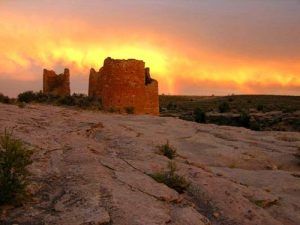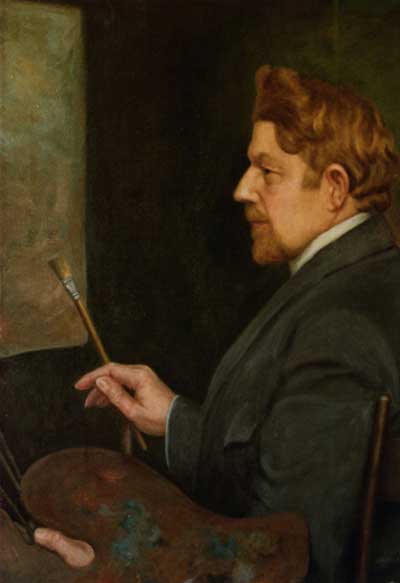
Frederick Melville DuMond, painted by DuMond’s daughter Camille.
The adventuresome artist Frederick Melville DuMond (1867-1927) had a period of intense work painting in Arizona, New Mexico, and Southern Colorado in the summer of 1910. He planned “twenty or thirty views or scenes painted from nature and interesting in ethnology and geology and varying from 2½ ft to 4 ft largest dimension…. so as to be able to show to our people the peculiar wonderland which is our great Southwest,” including “such scenic marvels as the Grand Canyon, petrified forests, cliff dwellings, Indian villages, etc.” (letter drafts). These were for a major artistic exhibition, and in 1912, March 9 – 23, the American Museum of Natural History hosted a show of 34 of his paintings.
That summer in 1910, DuMond traveled from New York City to Colorado, taking the celebrated “circular route” railroad trip in southern Colorado and visiting sites there. DuMond’s first stop was to paint the famed ruins at Mesa Verde; he was there between June 12 and June 16. He next visited New Mexico and then Arizona. There, he stayed with the famous Indian trader Lorenzo Hubbell, who outfitted him for a two to three-week painting trip into Canyon de Chelly and other sites nearby.
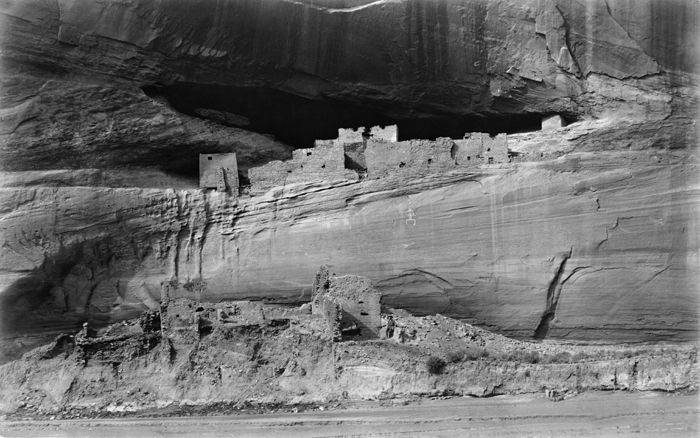
White House, Canyon de Chelly, 1922
Later that winter or the next spring, having returned to New York City to complete his trove of paintings, the artist thought about publishing his adventures. He wrote out two narratives. Although he never finished them, it is clear that he had planned to submit them to Outing, a well-known American annual magazine about sports and the outdoors.
Frederick Melville DuMond was my great-grandfather, and our family owns his notebooks and other documents. Here is a portion of his narrative of his painting adventures in the Mesa Verde area. This specific episode occurred at a location that he called the Grand Canyon of the San Juan River, about 30 miles from Mesa Verde, probably actually Grand Gulch. Charlie Ashleigh, who played cornet in the band of a circus, was his guide and companion on this adventuresome occasion.
By Richard Panofsky
Lost Treasure in Southern Colorado in 1910
Historic text by Frederick Melville DuMond, 1911
Although, like other boys, I had been brought up on baseball, skating, fishing, and other sports, still at an early age, I evinced a great and secret longing to visit the weird corners of old earth, perhaps because our father always had an overwhelming weakness for the different -ologies, and I had grasped at the dinner table bits of the conversation along scientific lines. However it came about, it had always been my great desire to live for a period in the homes of the different cliff dwellings — to be more able to imagine their mode of living and possibly to open up a secret stairway, as it were, leading to the chamber of mysteries surrounding this great people of the past. It is not my intention to attempt to write anything scientific on the subject but rather to paint a word picture of them and their possible mode of living, their beautiful villages, as per the impressions I received as an artist to better express myself — I should say impressions received and influenced by an artist’s imagination…. I once more hear Charley Ashleigh urging on the pack horse, once more in the saddle, and we are lost in a cloud of dust that would pale an Arizona sandstorm into insignificance. Only twelve miles of this, however, from Mancos to the foot of the mesa — but twelve miles of this was to my tenderfoot soul like pink lemonade at the circus — quite absolutely necessary — and the most picturesque dust effects imaginable have affixed themselves which will someday seek their expression in paint….

Cliff Palace is the largest cliff dwelling in North America. The structure, built by the Ancient Pueblo Peoples (also called the Anasazi), is located in Mesa Verde National Park in the southwest corner of Colorado. Photo from 1918
I remember one beautiful afternoon, we were passing along the rim of an out-of-the-way canyon leading to the Grand Canyon of the San Juan. Charley was telling me of when he played the first cornet in Barnum and Baileys circus and how he was in the middle of a solo when the sight of a small boy sucking a lemon — the shank of his instrument full to overflowing — when suddenly he bethought himself of the only expedient to finish his solo, he sang it, such was the power in the control of his voice, etc., etc. At this point, I thought I had him and requested him to kindly repeat that portion of his solo. He apparently never heard me as he suddenly spurred his animal ahead, gesticulating to me to follow. He rode straight through the cedars to the rim and pointed toward a peculiar cone-shaped tower standing in a recess not forty feet from the top on the opposite rim of the canyon. We hurried round the end of this small blind canyon, as it proved to be, and which we since named Chimney Canyon, and arrived with a coil of rope from the camp. In a few moments, we had descended and swung in upon the ledge. This Charley claimed was the storehouse with north exposure of which he had so often spoken. It certainly did have all the earmarks of a storehouse, as we discovered quantities of corn and cobs therein with many small niches in which small pots and urns were deposited.
But strangely enough, search as we would, we could find no trace of an opening into their tower or chimney and had begun to believe that this was simply a monument to some defunct chief or important personage, although without doors. Then there were slits at about four feet from the top, and we concluded that there was possibly an altar at the top of this monument.
Something brownish in color and peculiar in shape protruded from one of the slits; corn cobs had been inserted in the mortar at the angles made by the stones in the masonry. We went above, and with an improvised ladder (we had cut a long hemlock and chopped off its branches at about 6 inches from the trunk), Charley descended first. And I swung the ladder into him and followed, after setting the ladder in position, steadied it while Charley ascended. Upon looking into the top, I was startled by some of Charley’s choicest circus language, which I think could be perhaps more to the interest of Outing if omitted right here. It had its effect; however, in an instant, I was gazing upon the possible explanation for the disappearance of these wonderful and mysterious people. And what we had seen from below protruding from the slit opening in the side of the tower, as tower it was, was nothing short of a human hand. An arrow, the head of which tool is alongside me on the study table as I write, had pierced the eye in the same manner as in the death of Harold of England. In falling, it had tried to grasp this opening, and as the slit was narrower than his hand, he could not remove it and so had for centuries hung mummified by this desert air. There were cross beams at about two feet from the top on which he had probably been standing when shot, and he had fallen through.
We struck some matches and discovered what seemed to be steps about eight feet from the top. Charley was already descending while I was trying to remove the mummy without disturbing the peculiar little breech cloth about his middle, calling to him to lift the body. At the same time, I unfastened the hand from above. I received no reply and often repeated calls with no result; I decided to descend, fearing he had fallen and fainted, as the base of the tower was not more than 35 feet below, and he could easily have heard me, and I realized he had taken the matches. So I groped my way in the growing darkness. I counted the descending spiral steps, and we had counted 83, averaging one foot in height. I knew I was far below the floor of the cave when I felt a sudden draft of air full in my face. While feeling for the supposed opening, I heard a faint call from directly before me, and reaching out my hand, I discovered that there was the opening. Groping along this on my hands and knees in the dust of centuries, I soon found that the passageway would permit me to stand erect. Charley’s voice became more distinct, and I could plainly see that he was excited. He told me to run and was just saying, “Be careful,” when I plunged headlong into what later we concluded was a subterranean reservoir to be used in case of siege. Splashing out onto the other side, I ran on another ten feet. The tunnel was now ascending and becoming smaller, and I saw a faint light. This proved to be reflected from at right angles. Turning the corner, I could once more see God’s sunlight streaming in from the glory of the setting sun — and before me the most marvelous prehistoric village in all this world, in an almost perfect state of preservation.
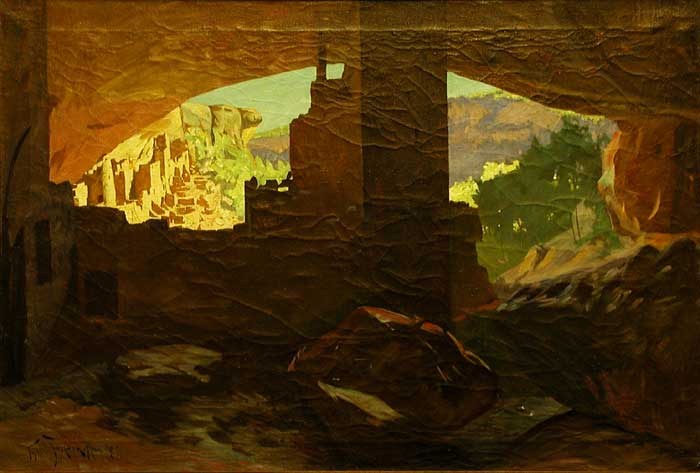
Painting from the inside of Cliff Palace, Mesa Verde, by Frederick DuMond.
Charley was nowhere to be seen. Calling to him, he proved to be in one of the houses, a beautifully decorated palace with a painted serpent over the top outside the T-shaped doors (to permit entering with a load upon one’s back) — made it possible for me to see Charley inside standing beside a long row of wonderfully decorated urns. He was examining something closely which he held in his hand. It later proved to be pure gold shavings evidently cut out with a modern pick ax, 3 shovels well worn, and a carbine of the old make. The urns were all nearly full of dust, under which we found chips and long shavings of pure metal. To stand before these riches and realize that we were now practically beyond the further necessity of being paid per line for Outing and per song by the circus band was too much for us, lost! All the beautiful ideas, no further planning to meet the landlord face to face, or perhaps to avoid him.
When we came to our senses, we tried to plan to take away our newfound riches. The urns were too large to go through the passageway. And I had, before leaving civilization, been made by the museum… a most tempting offer for any relics or mummies found, and these urns certainly were the peers of any I had ever seen in any museum. As we could neither see above nor below, it was impossible to say whether we would be able to lower them to the canyon below or lift them above the rim of the mesa. One thing certain was that we had passed entirely through the promontory to the other side. This we knew because we could faintly hear the ting-a-ling of our “bell mare” from above.
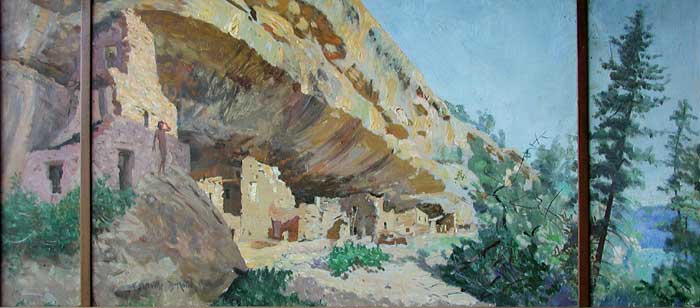
Ruins amongst the spruce trees, Frederick DuMond
As it was becoming rapidly dark, we decided to return to camp. With the necessary tackle and proper engineering, we managed to haul the urns above… This time, with the few remaining dry matches, we found, to our dismay, that our full length of rope had fallen from above; fortunately, we had had the foresight to attach the lower end to our improvised ladder. So we hauled it in for use in extricating ourselves from our prison — impossible to descend from this side, as our rope lacked a good 75 feet of touching the canyon bottom from our side. But how did that cord manage to drop, as we had securely fastened it with a single bow knot to a large spruce tree. Possibly Lill, the “bell mare,” had untied this bow knot by biting at it as she often did at her hobbles. At any rate, the rope had fallen, and the only ray of hope remaining was to redescend through the tower and tunnel and try to lower ourselves and scale the face of the cliff. Possibly, we could find some ledge leading below or some talus, as is often the case. It was perhaps all the more dangerous because it was by now quite dark; perhaps for this reason, the undertaking seemed less perilous, as we could not see the great depth below as we gently let ourselves down over the sloping edge of the cliff. As we had expected, we had but a few feet to drop onto the steep talus, covered with a heavy growth of spruce, down which we rolled and stumbled. We struck out in the black night to descend the bed of the canyon and, after about two hours of stumbling, finally came upon a spring in the middle of the trail. Charley knew the track from there to another short blind canyon, up which we clambered to the mesa above. In another 25 minutes, we were boiling coffee at camp, where we found our impatient horses had hobbled.
And try as we would the following morning, we could not discover our mysterious tower, nor have we ever since been able to find the spot. From below, it is as hopeless as from above. And someday, I shall again return to this spot and, with ample provisions, shall once more try to locate this treasure house.
By Frederick Melville DuMond, 1911, submitted by Richard Panofsky, April 2020. Updated January 2024.
Note: A scholarly treatment of this artist is found in Richard Panofsky Art and Ambition, 1887-1927: Frederick Melville DuMond, An American Painter of his Time (Raleigh, NC: Lulu, 2010). Richard is now working on a revised second edition.
Also See:
Historical Accounts of American History
Ancient Cities and Places of the Native Americans

